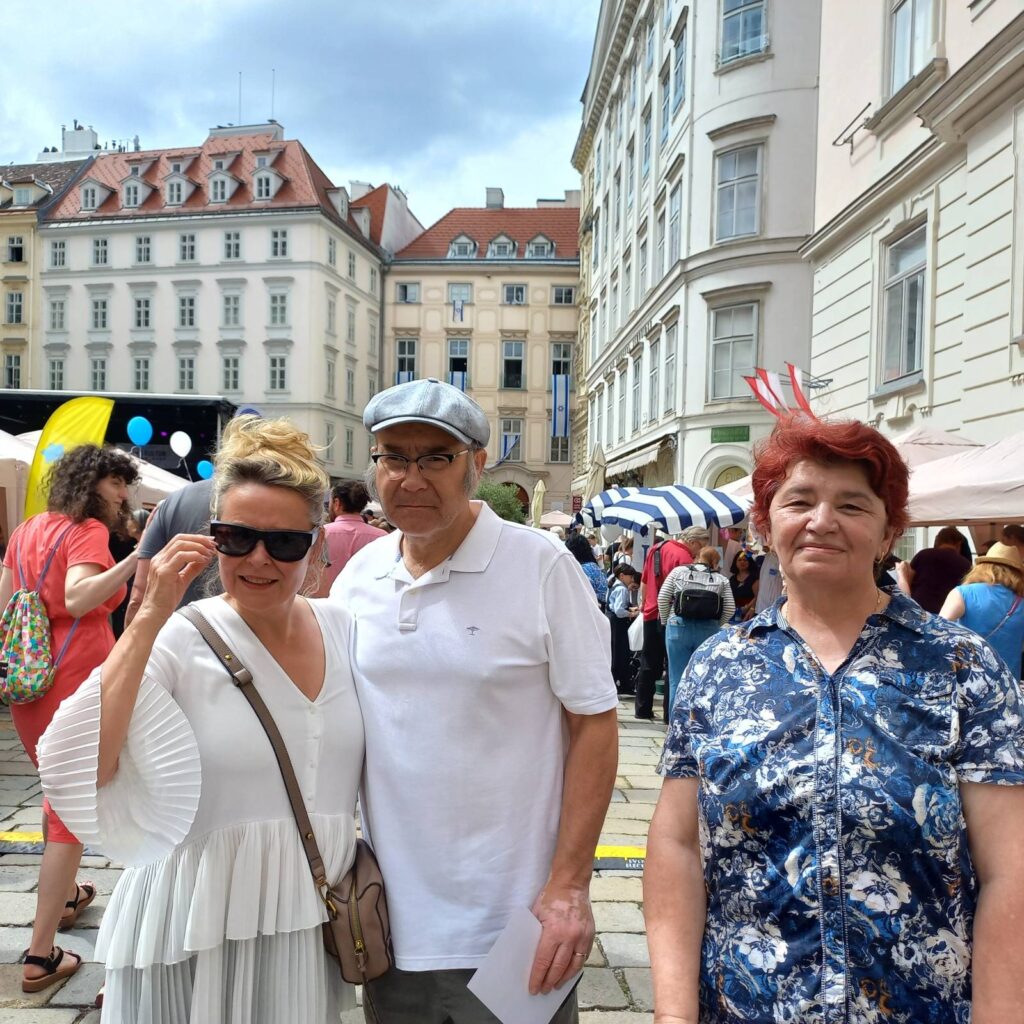At the invitation of Anne and Hannu Ylitalo, Janina Ilie from the Federation of Jewish Communities in Romania came to Vienna for a long weekend at the beginning of June 2024.
The highlights of her stay were a relaxed exchange over dinner with musical accompaniment on the electric piano by Andrei Roth, a trip to Kahlenberg including a panoramic view of Vienna, a leisurely car sightseeing tour through the city, a joint stroll at the Jewish Street Festival on Judenplatz and a visit to the oldest Jewish museum in the world.
Janina summed up her impressions, which she gained at the two locations of the Jewish Museum Vienna (Dorotheergasse and Judenplatz), very impressively for us:
The Jewish Museum of Vienna – A Whole Experience in Itself
“The museum is the most powerful arsenal with which a people defends its origin, identity, and all that it has inherited from its ancestors.”
It’s a warm summer day, and I’m enjoying it with dear friends in Vienna. Today, we are visiting the Jewish Museum, the oldest Jewish museum in the world. It’s an open history lesson about the Jewish community in Vienna — its contributions, notable figures, thematic exhibitions, archives, religious artifacts, and celebrations.
The Jewish Museum of Vienna is designed with an organizing principle meant to convey a message and evoke an emotional response. Its grandeur is overwhelming — each exhibit tells a story, often a sad one, and these hundreds or thousands of stories create a miraculous phenomenon that guides us through centuries of Jewish history in Vienna. From the earliest documented Jews in Vienna, through the tragic events of November 1938 when 25 synagogues were destroyed, to the ghettoization of Viennese Jews, and into more recent times, the emotional impact is profound. The question “WHY?” still lingers, unanswered, as emotional memories stir once again.
In the museum, life is portrayed in its entirety — birth, Jewish holidays, education, family, the synagogue, the community — with all their collected experiences, both good and bad, beautiful and less beautiful. It is not merely a static summary of a centuries-old dynamic. The museum is a place for the meeting and confrontation of documented and reasoned ideas, for education and understanding. It seeks to raise awareness of the history of the Jews in Vienna, as well as Jewish religion and culture.
The museum has everything necessary to reconstruct the history of the Jews in Vienna and their contributions to the city’s development, immortalizing many Jewish figures through their creations. The exhibition “Viennese Nostalgia – Connected Memories” by the painter Emil Singer transports you to a past era, making you realize that what you see today was also seen decades ago, in reality.
With a library containing over 45,000 volumes, many in Yiddish and Hebrew, a carefully displayed collection of Jewish religious artifacts, and the synagogue ruins with a virtual plan — all these elements make the
museum a living entity that continues to evolve over time.
There is so much more I could say, but emotion overwhelms me, bringing back memories — between suffering, triumph, and gratitude towards my friends — Anne, Hannu, and Elisabeth, who gave me the joy of visiting this museum.
If you ever find yourself in Vienna, make time to visit the Jewish Museum — it’s a history lesson in dignity, education, and perseverance, particularly relevant in these times when antisemitism is haunting the world.
To truly grasp the miraculous phenomenon that is this Viennese museum, you must visit it — the atmosphere and grandeur will overwhelm you. In the end, when you realize that the museum is an experience in itself, you’ll say with satisfaction, “Danke/Toda!”
Thank you, Anne and Hannu Ylitalo, for the journey to Vienna and for all the joy it brought me!
Janina Ilie
Thank you very much, Janina!


